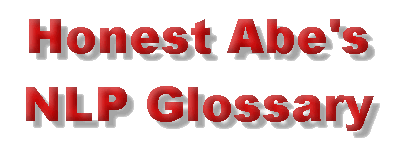

(author of "Develop Your NLP Skills", etc.)
PART 2
L - Q

|

|
|
|
(author of "Develop Your NLP Skills", etc.) |
||
|
PART 2 |
||
This glossary is designed to function at a very basic level, providing brief definitions, not detailed explanations. It will be particulary useful to newcomers who have heard or read very little about NLP so far. By the time you've read a half dozen of the better books you'll already know this stuff off by heart.
If there's anything you don't agree with, or which you think should be added, there is a "mail to" facility at the very end of this page. All constructive comments will be welcome.
Words in bold font are themselves explained somewhere within the glossary.